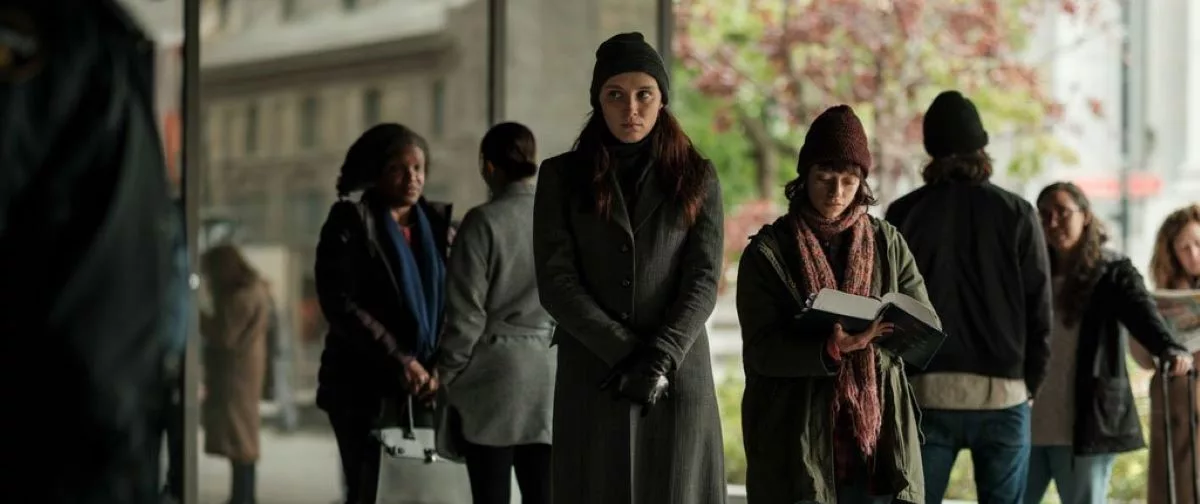Morbidity is part of the human condition. And the urge to rationalize an interest in dark topics — in particular, true crime — often ends up becoming a case of “the lady doth protest too much.” So it’s refreshing that Pascal Plante’s Quebecois techno-thriller “Red Rooms” makes no effort to explain or excuse its heroine’s fascination with the ghoulish serial killer whose trial she attends every morning as if it’s her job. (It isn’t.) And her real motivations remain unsettlingly obscure until the end of the film.
Plante’s unblinking screw-tightening builds to one of the most jaw-dropping scenes of this or any year, in which Kelly-Anne (Juliette Gariépy) shows up at the Montréal courthouse one morning dressed as a 13-year-old victim of accused murderer Ludovic Chevalier (Maxwell McCabe-Lokos), down to the schoolgirl uniform and retainer. Kelly-Anne bears a striking resemblance to the girl and seems to get a sexual thrill out of meeting Ludovic’s gaze as she’s dragged out of the courtroom. Ludovic waves. Kelly-Anne smiles. The girl’s screams rip across the soundtrack. It’s sickening, and the chilly filmmaking turns operatic for a moment to enhance the emotion.
In some ways, the hyper-intelligent, hyper-disciplined Kelly-Anne is a Lisbeth Salander type. She’s a loner who lives in a sterile high-rise apartment and makes her money playing high-stakes poker online. She occasionally models for a jewelry company, but otherwise seems to have no personal ties. She’s also a hacker, and some of the film’s most interesting sequences show exactly how a person like Kelly-Anne could access networks and accounts that could lead, say, to a stranger being able to break into a dead girl’s house and take selfies in her bedroom. The difference between Lisbeth and Kelly-Anne is that Kelly-Anne really goes there, in amoral ways that few film characters do.
Gariépy reveals very little about her character’s state of mind in these moments, and this ambiguity is what makes “Red Rooms” so intriguing. Everyone, including the audience, assumes that Kelly-Anne is one of Ludovic’s “groupies” — a hybristophiliac, to use the technical term. Plante lightly explores the mindset of these women through the character of Clementine (Laurie Babin), a country girl with an irrational fixation on proving Ludovic’s innocence who strikes up a tentative friendship with Kelly-Anne. And we do need a confused, pathetic Clementine to show us how truly cold and emotionless Kelly-Anne really is — even if her story ends up being a sluggish diversion from the depraved main event.
A significant amount of “Red Rooms” consists of close-ups of Gariépy’s face as she coolly watches, both in the courtroom and on the monitors in her apartment where Kelly-Anne “researches” Ludovic’s case on the dark web. And because Gariépy’s performance is so controlled, small movements reveal much about the character’s intentions and emotions, such as they are. Her gaze doesn’t judge the viewer, but it doesn’t absolve them, either. And her icy inscrutability makes her a fascinating angle into a case that’s nothing but prurient interest, her dead eyes and blank expression a canvas onto which the viewer can project their feelings about snuff films, sadism, and the bottomless depths of human depravity.
The filmmaking lowers the temperature as well. The palette is overcast and gray, and the only emotion comes from the frenzied drumming and slashing electric guitar on Dominique Plante’s score. In the courtroom scenes, the camera mechanically pivots around the space, dispassionately observing the witnesses gathered to hear the salacious details of Ludovic’s network of “red rooms,” where he live-streamed torture and murder online. Plante tastefully declines to show these videos beyond a blurry still of a red-spattered room and some wrenching sound effects. This ends up being more effective than if “Red Rooms” had indulged in excessive gore, as it forces viewers to fill in the blanks themselves.
“Red Rooms” does finally defer to the viewer’s comfort in its final stretch — which is understandable, as otherwise, this film would be indigestible to mainstream audiences. But the problem is that those final ten minutes also undermine the boldest things about the previous forty, in which Plante and Gariépy provoke the audience with Kelly-Anne’s disturbing behavior. Still, they deserve credit for having the guts to creep up to the abyss and peek over the edge.




















